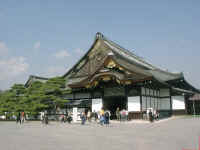 Page 1 2 3 4 5 6 7 8 9 10 11 12 13 14 15 16
Sunday, 13 October. Tom, Jane and I left at 9:15 for Kyoto and went directly to the Rokuon Temple, site of the famous Golden Pavilion (Kinkaku). Perhaps I should mention here that a "temple" in Japan is not necessarily a single building, but often is a complex of several buildings, as well as the grounds. The same is true of a "shrine." The distinction in terminology is important, too, because the temples are Buddhist, while the shrines are Shinto. The Golden Pavilion was built in 1398 as part of the retirement estate of a shogun (Yoshimitsu). When he died, the estate was turned into a Buddhist temple. There were several other buildings at that time, but only the Pavilion survived to the 20th Century. Then in 1950 the original Pavilion was burned to the ground by an arsonist. It was completely rebuilt five years later. Nevertheless, with its lovely setting on aptly-named Mirror Lake (Kyoko-chi), it is an impressive sight. And the beautiful garden is much the same as the one the shogun enjoyed six centuries ago.
From the Pavilion, we took a taxi to the Nijo Castle. The Castle is closely associated with the establishment of the Tokugawa Shogunate (1600-1867). It contains two separate palaces, the Ninomaru and the Honmaru. These originally dated to 1603 and 1626, respectively, but have been greatly modified and totally reconstructed over the years. In fact, the present Honmaru Palace is really an 1847 palace moved to this site from the Kyoto Imperial Palace grounds in 1893. The Castle complex is surrounded by a thick stone wall and a wide moat.
We went through the many rooms of the Ninomaru, most lined with painted gold silk
screens. Many of the rooms had costumed mannequins depicting 17th century court life.
Then we strolled the gardens. As we passed the Honmaru Palace, we heard voices from inside. Tom said the building was not open to the public and he'd never been inside. Upon inquiring, he learned that it was open today, apparently because of a three-day holiday. So we were able to tour that palace, too. There was very little inside, but it gave us a good idea of what a 19th century palace was like.
By prior arrangement, Kyoko met us for lunch. Afterwards, we walked through the
Nishiki Market, a long arcade featuring vendors of foods of all kinds. It was 4:15 when we got
back to Sakamoto.
Copyright © 2000-2023 DarrellPeck.com All rights
reserved. | ||||||||











